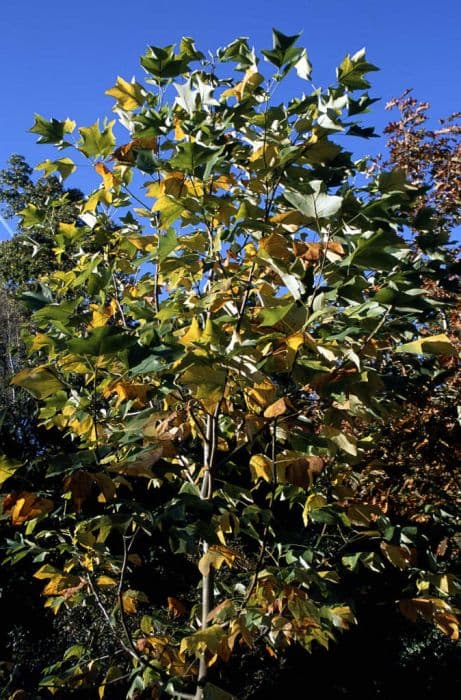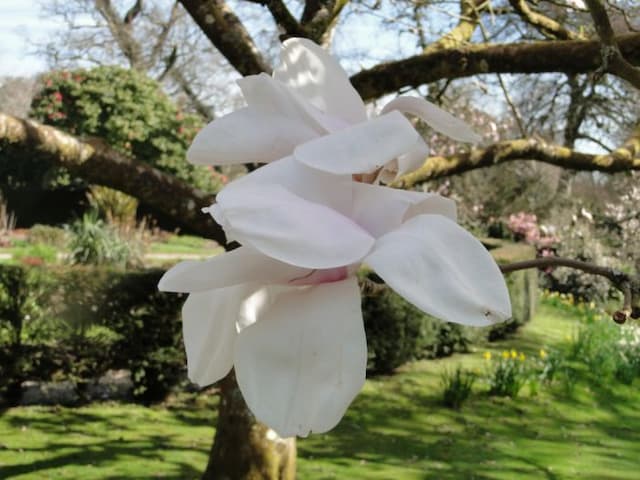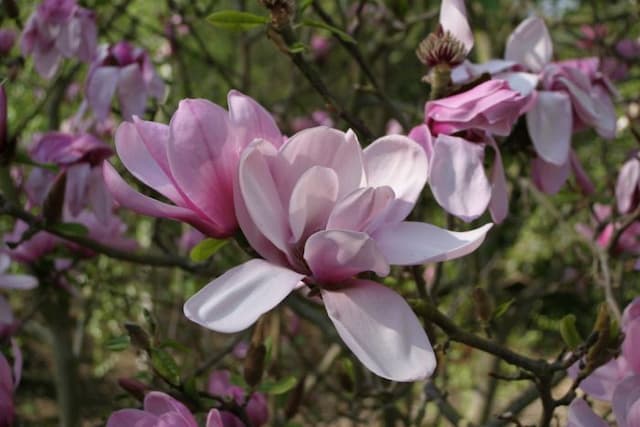Magnolia Magnolia 'J.c. Williams'

ABOUT
The Magnolia 'J.C. Williams' is a captivating plant known for its impressive flowering display. This variety features large, showy blossoms that are a feast for the eyes. The flowers, which are the standout feature of the plant, exhibit a beautiful blend of colors. The outer surface of the petals tends to have a rosy-pink hue, while the insides are often a soft, creamy white, giving the flowers a delightful two-toned effect. The petals themselves are broad and waxy, unfolding elegantly from fuzzy, tulip-like buds that hint at the splendor to come. When fully open, the flowers emit a sweet, citrusy fragrance that further enhances their charm and attracts pollinators as well as human admirers. The leaves of the Magnolia 'J.C. Williams' are also noteworthy; they are glossy and evergreen, providing a striking backdrop for the flowers. The foliage has a leathery texture and a rich green color that remains vibrant throughout the year. Overall, the form of the plant is graceful and well-structured, lending itself to a range of garden settings and uses. Its blossoming time, either at the end of winter or the start of spring, is a herald of warmer days and creates an exceptional visual impact in any landscape where it's planted.
About this plant
 Names
NamesFamily
Magnoliaceae
Synonyms
J.C. Williams Magnolia
Common names
Magnolia 'J.C. Williams'
 Toxicity
ToxicityTo humans
The Magnolia generally is not considered toxic to humans. However, as with any plant material, individuals may have varying sensitivities, and ingesting plant parts could potentially cause stomach upset or an allergic reaction in some people. If a person were to eat a significant amount of magnolia parts and experience symptoms, it is advisable to seek medical attention.
To pets
The Magnolia is not typically known to be toxic to pets. While it's unlikely that eating parts of this plant will cause serious harm to cats and dogs, ingestion can sometimes lead to mild gastrointestinal upset, such as vomiting or diarrhea. If a pet consumes a large amount of the plant and exhibits symptoms, it is best to consult a veterinarian.
 Characteristics
CharacteristicsLife cycle
Perennials
Foliage type
Evergreen
Color of leaves
Green
Flower color
Pink
Height
20 feet (6 meters)
Spread
15 feet (4.5 meters)
Plant type
Tree
Hardiness zones
7
Native area
Southeast Asia
Benefits
 General Benefits
General Benefits- Aesthetic Appeal: The Magnolia 'J.C. Williams' is known for its vibrant pink to red flowers that can enhance the beauty of any landscape.
- Shade Provider: As it grows, it can provide a substantial amount of shade in gardens or parks.
- Habitat for Wildlife: It offers shelter and food to a variety of birds and insects, including pollinators like bees and butterflies.
- Seasonal Interest: It has a long flowering period in the spring, adding interest to the garden throughout the season.
- Durability: Magnolias are known to be quite hardy and can withstand a variety of climates.
- Low Maintenance: Magnolia 'J.C. Williams' generally requires minimal maintenance once established.
 Medical Properties
Medical PropertiesThis plant is not used for medical purposes.
 Air-purifying Qualities
Air-purifying QualitiesThis plant is not specifically known for air purifying qualities.
 Other Uses
Other Uses- Photographic Subject: The vibrant colors and grandeur of the magnolia blooms make 'J.C. Williams' a popular subject for photographers and artists wishing to capture natural beauty.
- Holiday Decor: Magnolia leaves and flowers can be used to create stunning holiday wreaths and garlands for decorating during festive occasions.
- Culinary Uses: Although not a mainstream use, some cultures use magnolia petals as a spicy condiment or for flavoring rice and other dishes.
- Fragrance Production: The scent of magnolia flowers can be used in the making of perfumes and scented candles.
- Tanning Leather: The bark of the magnolia tree has been used traditionally in the tanning process to produce high-quality leather goods.
- Dyeing Fabric: The bark and flowers of magnolia can be used as a natural dye for textiles, giving a range of earthy tones.
- Specialty Woods: The wood from magnolia trees is sometimes used by woodworkers and craftsmen to create fine furniture and veneer.
- Botanical Education: Botanical gardens and educational facilities often utilize magnolia trees to teach about plant biology and taxonomy.
- Watercolor Pigment: The pigments derived from the flowers of the magnolia can be used in watercolor painting for artists seeking natural color sources.
- Mindfulness Practices: The serene beauty of the magnolia tree and its blossoms are sometimes incorporated into meditation and mindfulness gardens for their calming presence.
Interesting Facts
 Feng Shui
Feng ShuiThe Magnolia is not used in Feng Shui practice.
 Zodiac Sign Compitability
Zodiac Sign CompitabilityThe Magnolia is not used in astrology practice.
 Plant Symbolism
Plant Symbolism- Nobility: Magnolias are often associated with nobility due to their stately appearance and long history of being cultivated in the gardens of the wealthy and the powerful.
- Dignity: With their poised and elegant blooms, magnolia flowers symbolize dignity and grace.
- Purity: The pure white color of many magnolia blossoms is traditionally linked with purity and innocence.
- Perseverance: Magnolias are tough trees that can withstand harsh conditions, representing perseverance and endurance.
- Love of nature: Magnolias are ancient plants that have captivated humans for centuries, symbolizing a deep appreciation and love for the natural world.
- Femininity: The shape and texture of magnolia flowers have often been compared to feminine qualities, symbolizing gentleness and beauty.
- Hospitality: In the Southern United States, the magnolia tree is a common symbol of southern hospitality and welcome.
 Water
WaterFor the Magnolia 'J.C. Williams', commonly known as Saucer Magnolia, it is essential to water the plant thoroughly, making sure the soil is evenly moist without being waterlogged. During the growing season in spring and summer, water it once a week with about 1.5 gallons per watering session, depending on the weather and soil drainage. If rainfall is adequate, reduce the frequency of watering. In hot, dry spells, you may need to water twice a week. Cut back on watering in the fall and water sparingly in winter, just enough to prevent the soil from drying out completely.
 Light
LightSaucer Magnolia thrives in full sun to partial shade, with a preference for a spot that receives direct sunlight for at least four hours a day. Ideally, plant it where it will be sheltered from harsh afternoon sun, which can lead to scorching of the leaves, especially in Southern climates. East or west-facing locations with morning light or filtered afternoon light are excellent for promoting healthy growth and flower production.
 Temperature
TemperatureThe Saucer Magnolia is hardy in a range of temperatures but performs best in conditions that do not exceed 95°F in the summer and do not drop below -20°F in the winter. The ideal temperature range for active growth is between 70°F and 85°F. Ensure proper mulching to protect the roots from extreme cold and avoid planting in locations where cold drafts and sudden temperature drops are common.
 Pruning
PruningPrune Saucer Magnolia to maintain its shape and remove any dead or damaged branches. The best time to prune is soon after the tree finishes blooming in late spring or early summer. Light pruning can be done every year, but significant pruning should be carried out less frequently to avoid stress to the tree. Always use clean, sharp tools to make precise cuts and minimize the risk of disease.
 Cleaning
CleaningAs needed
 Soil
SoilThe best soil mix for a Magnolia 'J.C. Williams' should be rich, well-draining, and slightly acidic to neutral in pH (5.5 to 7.0). A combination of peat, compost, and coarse sand or perlite can improve soil structure and fertility.
 Repotting
RepottingMagnolia 'J.C. Williams' should be repotted every 2 to 3 years, in spring before the growing season begins, or when it outgrows its pot.
 Humidity & Misting
Humidity & MistingMagnolias, including 'J.C. Williams', prefer moderate humidity levels, but they are adaptable and do not require specific humidity conditions to thrive.
 Suitable locations
Suitable locationsIndoor
Place in bright indirect light, away from drafts, and water sparingly.
Outdoor
Choose a sunny spot, shelter from strong winds, and mulch annually.
Hardiness zone
7-9 USDA
 Life cycle
Life cycleThe Magnolia 'J.C. Williams', commonly known as saucer magnolia, begins its life cycle with seed germination after stratification, which occurs when seeds experience cold temperatures that break dormancy. Upon germination, the seedling grows through its juvenile phase developing a root system and foliage. As it matures, the saucer magnolia enters the vegetative stage, where it increases in height and width, growing sturdy branches that will support its large flowers. The reproductive phase follows, with the magnolia producing large, fragrant, showy flowers typically in early spring before the leaves fully expand. After pollination, usually by beetles attracted to the flowers, the tree sets seeds encased in cone-like fruit that mature and release seeds to begin the next generation. As a woody perennial, the saucer magnolia then enters a period of senescence in old age, where growth slows and the plant may begin to decline in vigor before eventually dying.
 Propogation
PropogationPropogation time
Spring-Early Summer
Magnolia 'J.C. Williams', commonly referred to as Magnolia, can be propagated by several methods, but the most popular and successful way is through semi-hardwood cuttings. This is typically done in late summer after the current year's growth has begun to mature and the wood is semi-ripe. You begin by selecting healthy, semi-hardwood branches that are about pencil-thick and 6 to 8 inches (15 to 20 centimeters) long. Cuttings should have at least two to three sets of leaves and should be taken early in the morning to ensure they are full of water. The leaves on the lower half of the cutting should be removed, and the cut end can be dipped in rooting hormone to encourage root development. The treated cutting is then planted in a well-draining medium, kept moist, and ideally placed in a propagator or under a plastic tent to maintain high humidity until roots have developed. It's important to avoid direct sunlight, which can overheat and dehydrate the cuttings.









![Magnolia [Felix Jury]](/_next/image?url=https%3A%2F%2Fplants-admin.emdemapps.com%2Fimages%2Fplants%2F%2Fimages%2F604b61a0b23b7.png&w=640&q=75)